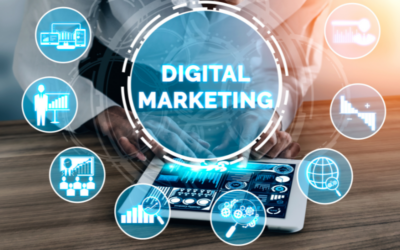If you’re in the B2B space, you know that digital marketing is critical for generating leads, increasing brand awareness, and driving conversions. But where do you start? This ultimate guide will take you through six comprehensive steps for creating an effective B2B marketing plan.
Let’s dive in!
Defining B2B Digital Marketing
First things first, let’s define B2B digital marketing. Unlike B2C marketing, which targets individual consumers, B2B marketing targets businesses and other organizations. B2B digital marketing involves using digital channels, like social media, email, and search engines, to reach and engage with these businesses.
While traditional marketing methods, like cold calling and trade shows, still have their place in the B2B world, digital marketing is becoming increasingly important. A recent survey found that 90% of B2B purchase cycles start with a web search.
The Importance of B2B Digital Marketing
Why is B2B digital marketing so important? For starters, it gives you the ability to reach more potential customers than traditional marketing methods. With digital marketing, you can target specific businesses and decision-makers with precision, and track the success of your campaigns in real-time.
Additionally, B2B digital marketing can help you build your brand and establish yourself as a thought leader in your industry. By creating valuable content and engaging with your audience on social media, you can position yourself as a trusted resource and differentiate your business from competitors.
Step 1: Define Your Target Audience
The first step in creating an effective B2B marketing plan is to define your target audience. Who are the businesses and decision-makers that you want to reach? Without a clear understanding of your audience, your marketing efforts will likely fall flat.
Identifying Your Ideal Customer
The first step in defining your target audience is to identify your ideal customer. What types of businesses do you want to work with? What industries do they operate in? What are their pain points and challenges?
One way to identify your ideal customer is to look at your existing customer base. Who are your best customers? What characteristics do they share? You can use this information to create a profile of your ideal customer, which will help guide your marketing efforts.
Creating Customer Personas
Once you’ve identified your ideal customer, the next step is to create customer personas. A customer persona is a fictional representation of your ideal customer, based on research and data. You can use customer personas to help you better understand your target audience and create more targeted and effective marketing campaigns.
To create customer personas, you’ll need to gather data on your target audience. This can include demographic information, like age, gender, and location, as well as information about their job title, industry, and pain points. Once you have this information, you can create a detailed profile of your ideal customer, including their goals, challenges, and interests.
Step 2: Develop a Content Marketing Strategy
Once you have a clear understanding of your target audience, the next step is to develop a content marketing strategy. Content marketing involves creating and sharing valuable content, like blog posts, infographics, and videos, to attract and engage your target audience.
Understanding the Buyer Journey
Before you can create effective content, you need to understand the buyer journey. The buyer journey is the process that businesses go through when making a purchasing decision. It typically involves three stages: awareness, consideration, and decision.
During the awareness stage, businesses are just starting to become aware of their pain points and potential solutions. During the consideration stage, they are evaluating different solutions and vendors. And during the decision stage, they are making a final decision and choosing a vendor.
Creating a Content Calendar
Once you understand the buyer journey, the next step is to create a content calendar. A content calendar is a schedule that outlines the content you will create and share over a set period of time. Your content calendar should be based on your customer personas and should align with the different stages of the buyer journey.
When creating your content calendar, consider the different types of content you can create, like blog posts, videos, infographics, and case studies. You should also consider how you will promote your content, using channels like social media and email marketing.
Step 3: Utilize Social Media Marketing
Social media can be a powerful tool for B2B digital marketing. By creating and sharing valuable content on social media, you can reach and engage your target audience, and drive traffic to your website.
Choosing the Right Platforms
When it comes to social media, it’s important to choose the right platforms. Not all social media platforms are created equal, and some may be more effective than others for reaching your target audience.
Consider the demographics of your target audience, as well as their interests and pain points. This can help you determine which platforms are most likely to be effective for reaching and engaging them.
Creating a Social Media Plan
Once you’ve chosen the right platforms, the next step is to create a social media plan. Your social media plan should include a schedule for posting content, as well as a plan for engaging with your audience and responding to comments and questions.
When creating your social media plan, consider the types of content that are most likely to be effective on each platform. For example, LinkedIn is a great platform for sharing industry news and thought leadership content, while Twitter is more effective for short, snappy updates.
Step 4: Implement Search Engine Optimization (SEO)
Search engine optimization (SEO) is the process of optimizing your website and content to improve your ranking in search engine results pages (SERPs). By optimizing your content for search engines, you can increase your visibility and attract more traffic to your website.
Keyword Research
The first step in implementing SEO is to conduct keyword research. Keyword research involves identifying the search terms and phrases that your target audience is using to find businesses like yours.
You can use tools like Google Keyword Planner or SEMRush to identify relevant keywords and assess their search volume and competition. Once you’ve identified your target keywords, you can use them to optimize your website and content.
On-Page and Off-Page Optimization
There are two main types of SEO: on-page optimization and off-page optimization. On-page optimization involves optimizing your website and content to make it more search-engine friendly. This includes optimizing your website structure, meta tags, and content for your target keywords.
Off-page optimization involves building backlinks to your website from other high-quality websites. Backlinks signal to search engines that your website is authoritative and valuable and can help improve your rankings in search engine results pages.
Step 5: Utilize Email Marketing
Email marketing can be a highly effective tool for B2B digital marketing. By building an email list and creating effective email campaigns, you can nurture leads, build relationships with your audience, and drive conversions.
Building an Email List
The first step in utilizing email marketing is to build an email list. You can do this by offering a lead magnet, like a whitepaper or ebook, in exchange for a user’s email address.
Make sure that your lead magnet is relevant to your target audience and provides real value. You can promote your lead magnet on your website, through social media, and through other channels to attract new subscribers.
Creating Effective Email Campaigns
Once you’ve built an email list, the next step is to create effective email campaigns. Your emails should be personalized, relevant, and targeted to your audience’s interests and pain points.
Consider using a marketing automation platform like HubSpot or Marketo to help you create and manage your email campaigns. This can help you save time and improve the effectiveness of your campaigns.
Step 6: Measure and Adjust Your Strategy
Finally, it’s important to measure and adjust your B2B digital marketing strategy over time. This involves tracking metrics like website traffic, email open rates, and conversion rates, and using this data to refine your approach.
Tracking Metrics
There are many different metrics that you can track to measure the effectiveness of your B2B digital marketing strategy. Some key metrics include website traffic, bounce rate, time on site, email open and click-through rates, and conversion rates.
Make sure that you’re tracking the right metrics for your business and goals. You can use tools like Google Analytics or HubSpot to track and analyze your data.
Adjusting Your Strategy Based on Results
Once you’ve gathered data on your B2B digital marketing campaigns, it’s important to adjust your strategy based on your results. This might involve tweaking your content strategy, adjusting your social media plan, or trying new channels or tactics



